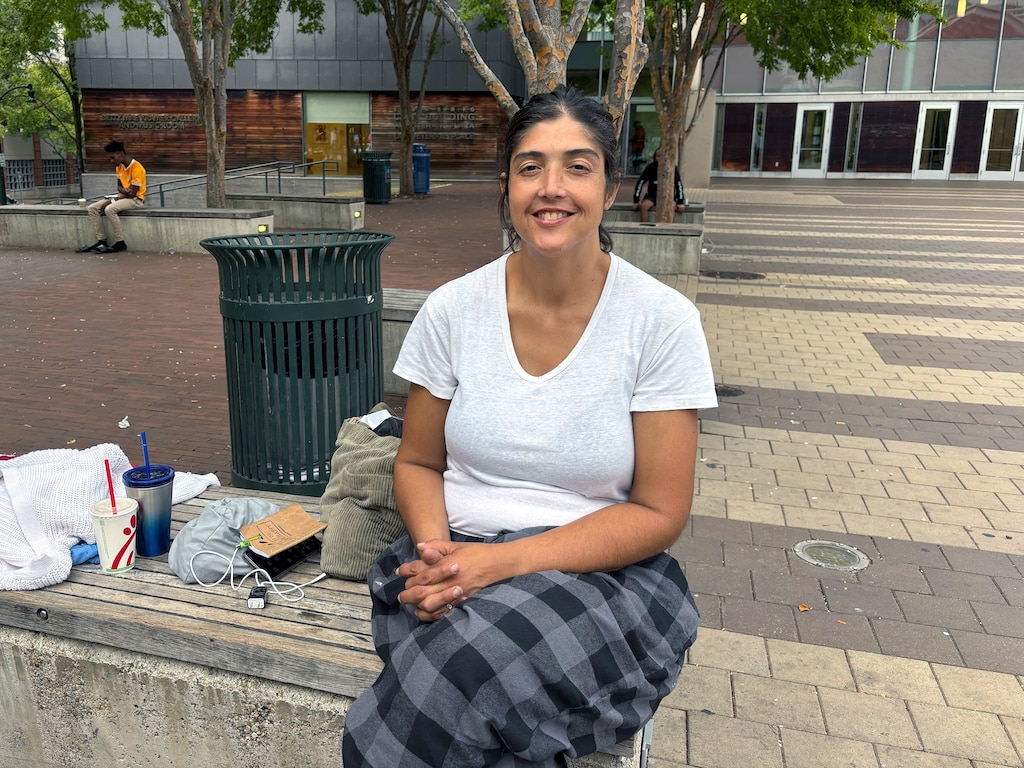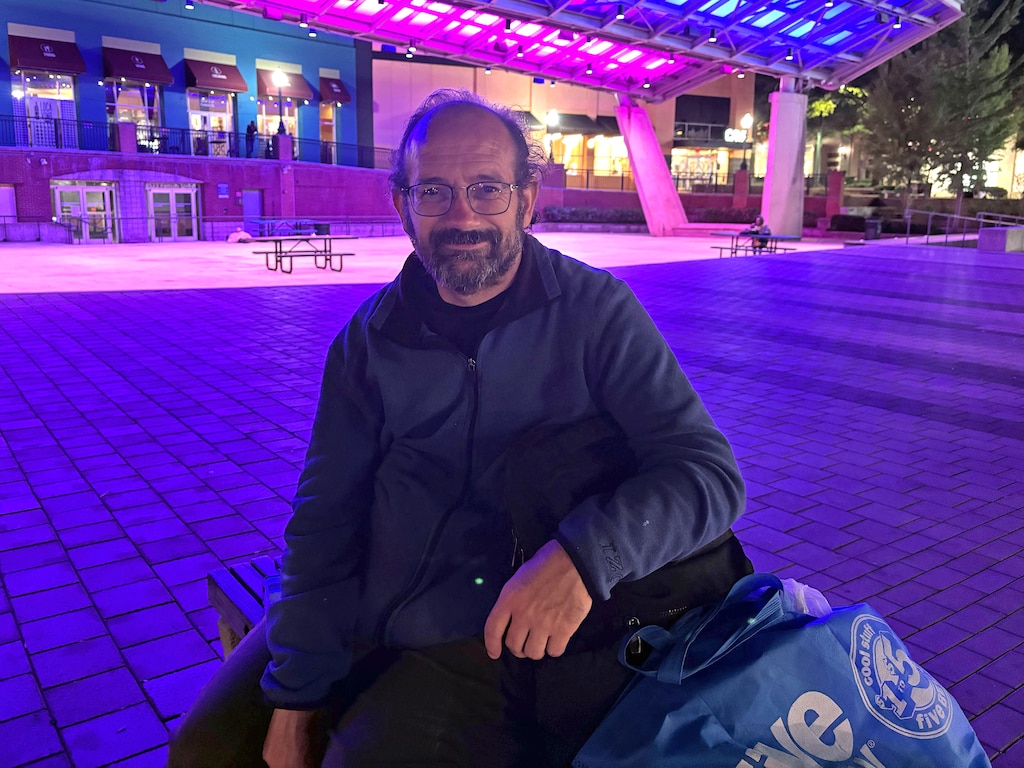Shatara Rolle spends hours every day in Silver Spring pinning flyers on traffic poles and peeking into libraries and abandoned buildings in search of young people in need of housing. A youth outreach specialist and someone who experienced homelessness herself, Rolle lets young people know about nearby drop-in centers that can offer help.
Rolle, who often comes bearing food and water, said she’s recently noticed more people turn away as she approaches.
“They don’t necessarily trust that we are even who we say we are,” Rolle, 42, said. “We could be police disguised to come out and harass them.”
The reticence comes after federal troops cleared more than 50 homeless encampments in neighboring Washington, D.C., after President Donald Trump deployed them about a month ago, arresting people who refused to move and throwing away their belongings.
“People who are experiencing homelessness often are experiencing being treated like trash,” said Hall, CEO of Interfaith Works. “And that is as we saw the images of how those encampments were being cleared in D.C.”
Many Montgomery County leaders are bracing for a potential increase in unhoused people displaced from D.C. But the crackdown has severed a lot of the trust housing advocates need to build relationships with people who are experiencing homelessness.
Shelter providers usually ask unhoused residents where they are coming from, but when the D.C. takeover began, they began recording that data, too. Tracking a potential increase is the first step to determining whether an additional response is needed, said Christine Hong, the county’s Chief of Services to End and Prevent Homelessness.
So far, fewer than 20 residents have come from D.C. — at least from those “who have been comfortable sharing.”
“People are less comfortable letting us know, which is an indication that people are fearful of sharing their identity,” Hong said.
The warm weather has meant people are living outside, so shelters haven’t yet seen more people. As winter looms, unhoused people who have made the 2-mile trek to Silver Spring since August will need housing.
Jimmy Slattery, program director at Interfaith Works, said staff and unhoused people also worry that crackdowns in D.C. might start happening in Montgomery County.
“With a lot of fear and uncertainty, people are hesitant to provide full information,” he said. “And without full information, we can’t get them into permanent housing programs.”
He also observed a marked decrease in the Spanish-speaking population that would often seek services from Interfaith Works since the immigration crackdown under Trump.
The Banner reached out to multiple shelter providers for comment. One shelter declined to comment on the record, saying it was “cautious to speak publicly given heightened federal sensitivity,” but acknowledged challenges.
Interfaith Works serves 35,000 people in Montgomery County every year and is one of several places offering shelter and drop-in services like free showers, meals and laundry. The shelter also provides other resources like financial assistance, help with job placement and a culinary program.
Inside its building, a chalkboard against bright blue walls announces an upcoming art club meeting. Slattery gestures towards a room packed to the ceiling with 130 black mats spread throughout the building for people to sleep on in the winter.
N’Jeri Henry, deputy director of Interfaith Works, said clearing encampments is a group effort that requires time to build trust and establish a plan for people’s belongings. When police disperse an encampment community overnight and throw out their things, unhoused residents’ distrust of authority only grows, she said.
“Many individuals try to seclude themselves and be out of the way,” Henry said. “The likelihood of us being able to have easy access to them is going to be very difficult.”
Homelessness has been increasing for years nationwide as housing costs rise. The average Marylander needs to work 2.6 full-time minimum wage jobs to afford a two-bedroom apartment.
Montgomery County has had one of the highest increases in homelessness in the state, and the numbers have worsened since the pandemic. Homelessness in the county increased 32% last year, and 162% the last five years. In August, the county provided shelter and outreach to about 1,300 individuals.
Last year, Interfaith Works sheltered a record 200 people in one night. Sometimes, there aren’t enough mats, and people will sleep in chairs.
“Where we can find space, we will make space,” Henry said.
Slattery said the main reason unhoused people don’t go to shelters is that there is almost never enough space. While drop-in services like a shower or a warm meal are available to anyone at Interfaith Works, there aren’t enough long-term shelter beds. Any bed that opens gets occupied within twenty minutes, Slattery said.
John Combs, who has lived on a plaza in downtown Silver Spring since 2019, said he has been trying to secure housing for five years.
His 4-year-old son was adopted into foster care in June while Combs was in jail.
“If I had gotten a home, I would have gotten him back,” said Combs, who used to work as a carpenter.
A regular of the same plaza, Alba Batres has been unhoused off and on for 14 years. She said that Trump is only human, but the crackdown has gone “overboard.” She prays for him to “get off his high horse.”

“He thinks we’re peasants or under his feet,” she said. “We’re not. We’re human.”
People might also be hesitant to go to a shelter because they are full of strangers and can have people using drugs or struggling with mental health, some unhoused people said. During the winter, however, shelters are a matter of life and death.
Rolle, who was evicted from her home in 2022 because she couldn’t keep up with rent, said her own experiences in shelters were unpleasant. They are restrictive, but they are also a necessary step to eventually get assigned to housing, she said.
Rolle felt angry about Trump’s targeting of unhoused people — especially given the administration’s proposed goal in July to slash funds for homeless assistance programs.
“You’re demonizing people for being homeless, but not offering them help when these people are vulnerable,” said Rolle, a Florida native who has lived in Montgomery County for six years. “It’s basically making it a crime to be poor.”

Hong worries that the administration’s crackdown will give the impression that shelter is a solution to homelessness. She said shelter is often more costly than permanent housing.
“Shelter is intended to be a temporary place for people to stay,” Hong said. “Providing housing is the only solution that permanently ends an individual’s experience of homelessness.”
When asked what she wished more people knew about being homeless, Rolle said it could happen to anyone.
“It’s not a result of some moral deficit or thing like that,” Rolle said. “Anyone can fall on hard times.”
“We should look out for each other,” she added.
What can you do?
“Providing a little bit of humanity is always an easy thing to do,” Slattery said.
Individuals often ignore people who are experiencing homelessness, and that can be “completely demoralizing,” Slattery said. You don’t always have to give money, just acknowledge the person’s presence — make eye contact, say hello, hand over a bottle of water, he said.
You can also call the homeless information line and let them know where someone is so they can provide relevant resources. Volunteer with a nearby shelter, donate or help spread information about shelters and services.
“Often, when we talk about the issue of homelessness in the county, the problem can sound so large, so unsolvable,” Hall said. “It is, in fact, solvable.”




Comments
Welcome to The Banner's subscriber-only commenting community. Please review our community guidelines.